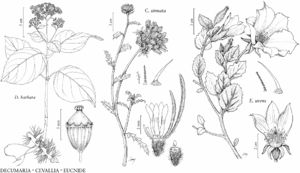Eucnide
Index Seminum (München) 1844: [4]. 1844.
| Taxon | Illustrator ⠉ | |
|---|---|---|
 | Eucnide urens Cevallia sinuata Decumaria barbara | Linny Heagy Linny Heagy Yevonn Wilson-Ramsey |
Herbs or subshrubs, annual or perennial; trichomes (1) pointed with surfaces ± smooth, (2) retrorsely barbed along shaft and at apex or only at apex, and (3) stinging. Stems usually erect or spreading, rarely prostrate or pendent on cliffs. Leaves cauline; petiole present; blade ovate, lobed or unlobed, margins crenate or dentate. Inflorescences dichasia and monochasia [solitary flowers]; peduncle inconspicuous [conspicuous]. Pedicels elongating in fruit. Flowers: hypanthium completely adnate to ovary; perianth whorls differentiated; sepals green, distinct, lanceolate, straplike, or narrowly ovate, shorter than petals; petals white, green, or yellow [reddish orange], connate proximally to 1/2+ length, spatulate or ovate, spreading or erect (then corolla essentially tubular) [erect proximally, divaricate distally (corolla salverform)], glabrous except apices sparsely hairy; nectary distal on ovary; stamens 15–150+, exserted or included; filaments monomorphic, filiform, longer or shorter than anthers; anthers without distal connective extension; staminodes absent; pistil 5-carpellate, placentae parietal; stigma lingulate, 5-lobed, papillate. Fruits capsules, dehiscing by apical valves [splitting longitudinally], cupshaped, straight; sepals persistent. Seeds many, cylindric to ovoid, not dorsiventrally flattened, to 1 mm, not winged. x = 21.
Distribution
sw, sc United States, Mexico, Central America (Guatemala)
Discussion
Species 14 (4 in the flora).
Eucnide was placed in subfam. Mentzelioideae by I. Urban and E. Gilg (1900), Gilg (1925b), and H. J. Thompson and W. R. Ernst (1967); however, this subfamily is paraphyletic. Eucnide has been placed in molecular phylogenetic studies as sister to the rest of Loasaceae (L. Hufford et al. 2003).
Three sections of Eucnide were recognized by H. J. Thompson and W. R. Ernst (1967). Section Mentzeliopsis H. J. Thompson & W. R. Ernst, consisting only of E. urens, was distinguished on the basis of its floral architecture in which all stamens are shorter than the style and not exserted beyond the corolla. The numerous stamens of E. urens are also tightly positioned around the style. Section Sympetaleia (A. Gray) H. J. Thompson & W. R. Ernst consists of three species that are endemic to the Baja California Peninsula and surrounding islands, except for E. rupestris, which has a distribution that extends into extreme southern California and southwestern Arizona and to Sinaloa and Sonora, Mexico. Species of sect. Sympetaleia have stamens with monothecate, bisporangiate anthers in contrast to other members of the genus, which have more conventional bithecate, tetrasporangiate anthers. All other species of Eucnide were placed in sect. Eucnide by Thompson and Ernst.
Among the North American species of Eucnide, E. urens is the only species found in the Mojave Desert, where it is centered (H. J. Thompson and W. R. Ernst 1967). The other North American species are found in the Chihuahuan and Sonoran deserts and in adjacent areas. All species are found in similar cliff or rocky slope habitats (uncommonly in arroyos and washes). Some species, such as E. bartonioides, have fruit pedicels that are negatively phototropic and elongate extensively, which appear to be adaptations for dispersal on cliffs (Thompson and Ernst).
Most species of Eucnide are self-pollinating (H. J. Thompson and W. R. Ernst 1967), although they generally have some spatial separation between the stigmas and anthers soon after the flowers open that allows for cross-pollination (L. Hufford 1988). Only taxa with the largest flowers, such as E. bartonioides var. bartonioides (possibly pollinated by hawk moths) and E. urens (pollinated by the melittid bee, Hesperaster laticeps), appear to be strictly outcrossing (Thompson and Ernst).
Selected References
Lower Taxa
Key
| 1 | Corollas essentially tubular, petals to 15 mm, connate to 9 mm, 2-colored, yellow to brown basally, green distally; stamen filaments less than 5 mm, inserted in upper portion of corolla tube. | Eucnide rupestris |
| 1 | Corollas funnelform or rotate, petals 10–55 mm, connate to 5 mm, 1-colored, white, cream, or yellow; stamen filaments 10–60 mm, inserted at base of corolla. | > 2 |
| 2 | Petals white to cream; stamens included, most aggregated around style, only longer, outermost stamens spreading away from style. | Eucnide urens |
| 2 | Petals yellow; stamens exserted, spreading away from style. | > 3 |
| 3 | Corollas funnelform; filaments 13–60 mm. | Eucnide bartonioides |
| 3 | Corollas rotate; filaments 7–16 mm. | Eucnide lobata |
"elongating" is not a number.